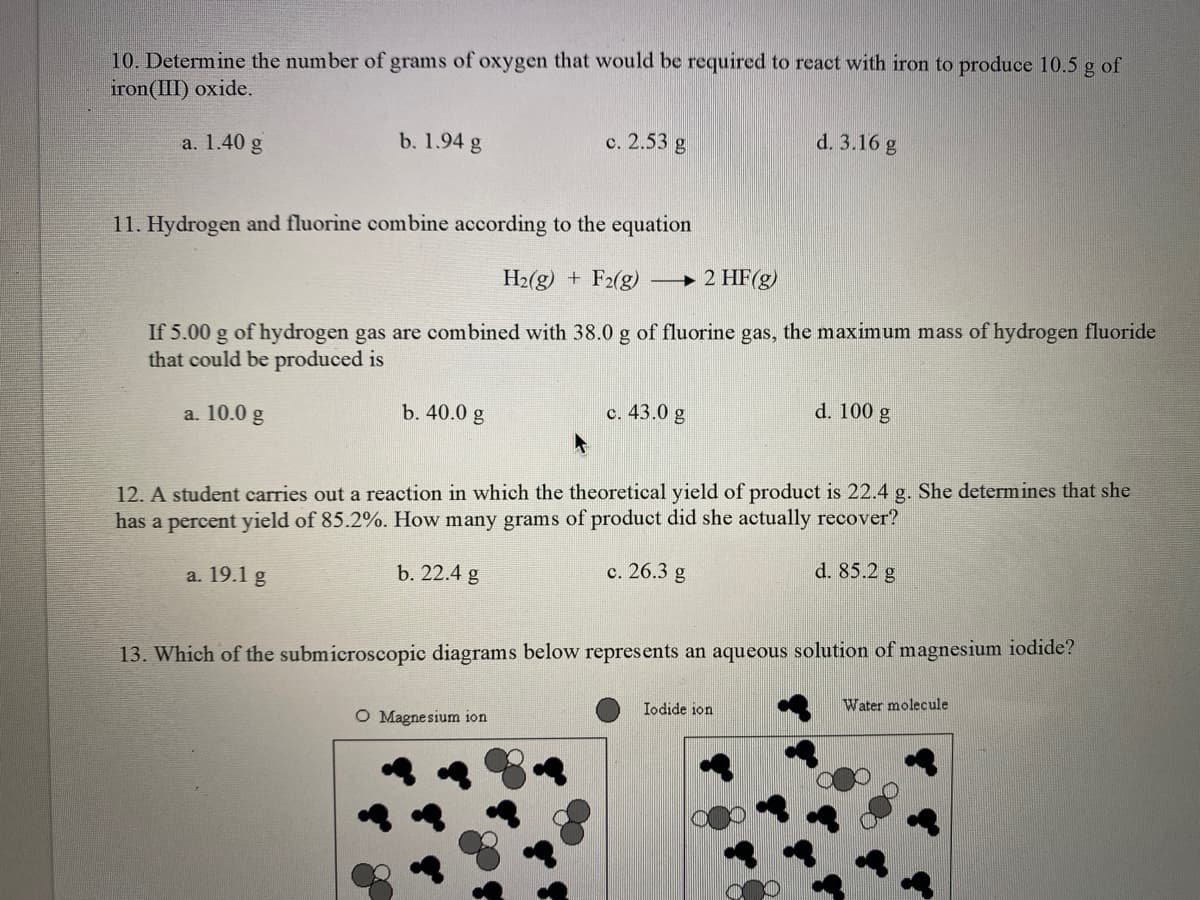11. Hydrogen and fluorine combine according to the equation H₂(g) + F2(g) → 2 HF(g) If 5.00 g of hydrogen gas are combined with 38.0 g of fluorine gas, the maximum mass of hydrogen fluoride that could be produced is a. 10.0 g b. 40.0 g c. 43.0 g d. 100 g
11. Hydrogen and fluorine combine according to the equation H₂(g) + F2(g) → 2 HF(g) If 5.00 g of hydrogen gas are combined with 38.0 g of fluorine gas, the maximum mass of hydrogen fluoride that could be produced is a. 10.0 g b. 40.0 g c. 43.0 g d. 100 g
Chemistry
10th Edition
ISBN:9781305957404
Author:Steven S. Zumdahl, Susan A. Zumdahl, Donald J. DeCoste
Publisher:Steven S. Zumdahl, Susan A. Zumdahl, Donald J. DeCoste
Chapter3: Stoichiometry
Section: Chapter Questions
Problem 117E: Bacterial digestion is an economical method of sewage treatment. The reaction is an intermediate...
Related questions
Question
#11 please

Transcribed Image Text:10. Determine the number of grams of oxygen that would be required to react with iron to produce 10.5 g of
iron(III) oxide.
b. 1.94 g
c. 2.53 g
a. 1.40 g
d. 3.16 g
11. Hydrogen and fluorine combine according to the equation
H₂(g) + F2(g) → 2 HF(g)
If 5.00 g of hydrogen gas are combined with 38.0 g of fluorine gas, the maximum mass of hydrogen fluoride
that could be produced is
a. 10.0 g
b. 40.0 g
c. 43.0 g
d. 100 g
12. A student carries out a reaction in which the theoretical yield of product is 22.4 g. She determines that she
has a percent yield of 85.2%. How many grams of product did she actually recover?
c. 26.3 g
d. 85.2 g
a. 19.1 g
b. 22.4 g
13. Which of the submicroscopic diagrams below represents an aqueous solution of magnesium iodide?
Iodide ion
Water molecule
O Magnesium ion
Expert Solution
This question has been solved!
Explore an expertly crafted, step-by-step solution for a thorough understanding of key concepts.
This is a popular solution!
Trending now
This is a popular solution!
Step by step
Solved in 2 steps with 2 images

Knowledge Booster
Learn more about
Need a deep-dive on the concept behind this application? Look no further. Learn more about this topic, chemistry and related others by exploring similar questions and additional content below.Recommended textbooks for you

Chemistry
Chemistry
ISBN:
9781305957404
Author:
Steven S. Zumdahl, Susan A. Zumdahl, Donald J. DeCoste
Publisher:
Cengage Learning


Chemistry for Engineering Students
Chemistry
ISBN:
9781337398909
Author:
Lawrence S. Brown, Tom Holme
Publisher:
Cengage Learning

Chemistry
Chemistry
ISBN:
9781305957404
Author:
Steven S. Zumdahl, Susan A. Zumdahl, Donald J. DeCoste
Publisher:
Cengage Learning


Chemistry for Engineering Students
Chemistry
ISBN:
9781337398909
Author:
Lawrence S. Brown, Tom Holme
Publisher:
Cengage Learning

General Chemistry - Standalone book (MindTap Cour…
Chemistry
ISBN:
9781305580343
Author:
Steven D. Gammon, Ebbing, Darrell Ebbing, Steven D., Darrell; Gammon, Darrell Ebbing; Steven D. Gammon, Darrell D.; Gammon, Ebbing; Steven D. Gammon; Darrell
Publisher:
Cengage Learning

World of Chemistry, 3rd edition
Chemistry
ISBN:
9781133109655
Author:
Steven S. Zumdahl, Susan L. Zumdahl, Donald J. DeCoste
Publisher:
Brooks / Cole / Cengage Learning

Chemistry: An Atoms First Approach
Chemistry
ISBN:
9781305079243
Author:
Steven S. Zumdahl, Susan A. Zumdahl
Publisher:
Cengage Learning